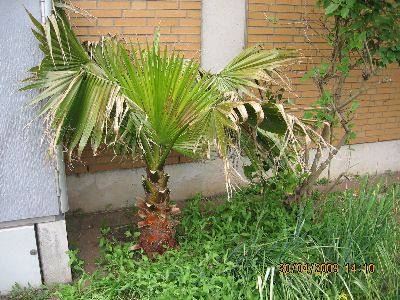
"Exotics" On Heligoland In Spring 2009
In the past year we couldn't report about the "exotics" on the red islands because of the lack of time and also weren't there. It has very much changed in the past year for Mr. Chris Stuehrk and me in the health, private and vocation so that we were disabled. Kindly Mr. Udo Harlichs from the power station on the Northeastern Area has kept our project, he took photos from the basjoo, the Washingtonia and the lemon for us, best thanks to him!
The Washingtonia filifera at the power station also has survived the past winter well, hardly damaged in the difference to the others of the same species on the mainland which are needing heated winter protection to overwinter outdoors with success. The at the power station is absolutely the only in Germany which has overwintered outdoors almost undamaged without winter protection successfully! The trunk of Washingtonia grew also in the diameter, this is also shown on the pics! It has proven that Heligoland is the only site in Germany where Washingtonia also is able to overwinter without winter protection at the windsheltered places outplanted outdoors! I'm wondering if Phoenix canariensis can also this? Till today no pics or reports about this yet, but they still will follow!
It surprised me, that Citrus lemon also has survived without winter protection the past winter 2008/09 closed to the wall of the power station right in the background of the Washingtonia, the damages are relatively slight. The Musa basjoo 'Sapporo' also had no problems, more about this see Probleme, mehr darüber siehe Banana Flower April 2009 On Heligoland. The past winter was nearly frostfree on Heligoland! Enormous differences in the past winter in total Germany, in some areas on the mainland even till -17°F, where some "exotics" died and other suffered by enormous damages by frost, the same but on the island also survived without heating and cover well.
I requested for further photos from the "exotics" on the island, anyone should be found on the island who has enough time to take photos from the "exotics" and the Jubaea chilensis at the hotel "Insulaner".

Washingtonia filifera at the power station on 30th April 2009, it already stands since several years outplanted there, the trunk grew in diameter! The damages are from the strong sea salt winds during the winter, but they are only slight at the power station.
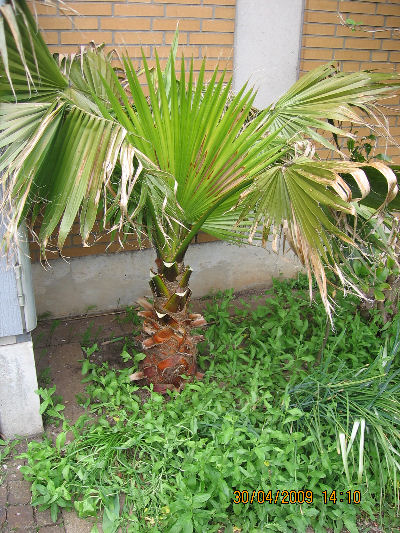
Closed view of the same palm, right in the background you can also see the Citrus lemon, which survived surprisely the past winter relatively well.
Luckily we could found anyone, who could take further photos. However not a Heligolandian, but one exotic friend from Leverkusen named Philipp Schaffran. Best thanks to him! He was with his grandpa for one day on the red island in the first week of June and was also passed the Insulaner Jubaea and could make photos. Also the trachies in the city he has photographed, at the same the "exotics" at the power station on the Northeastern Area. But he couldn't visit the James Krüss School and also couldn't meet with Ulf Martens, because his grandpa couldn't walk so much because of his high age. Therefore not many "exotics" could checked and photographed. But I hope, that Chris Stührk will have time in October and take holidays, so that we can go to the red island over the weekend and also can take more photos, so that one more detailed report will be possible.
The "exotics" on Heligoland have survived the past winter very well, unlike the many "exotics" on the mainland.
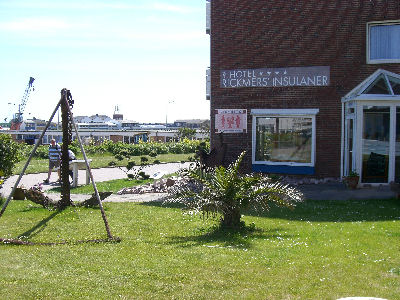
Insulaner Jubaea early June 2009, its feathered leaves were going over the nearly frostfree winter 2008/09 without winterprotection well, obviously the feathered leaves are clearly smaller than during the planting in spring 2004, it's now outplanted since 5 years.
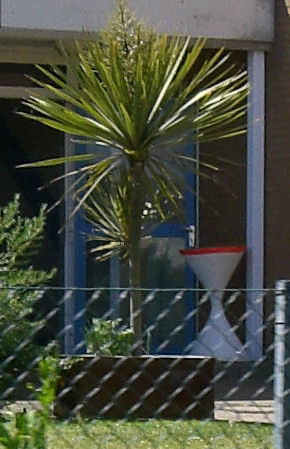
Cordyline australis already stands since years outdoors at the power station on the Northeastern Area, it seems to form one inflorescence.
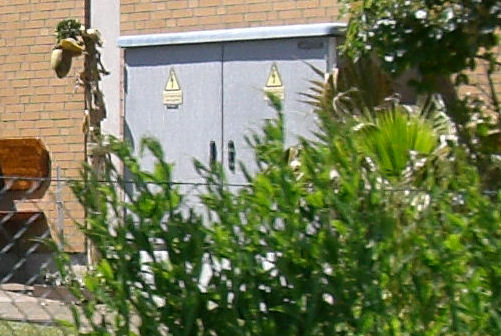
Fruiting Musa basjoo 'Sapporo' and Washingtonia filifera at the power station early June 2009. Whether the banana does sucker now, this is not cognizable on the picture.
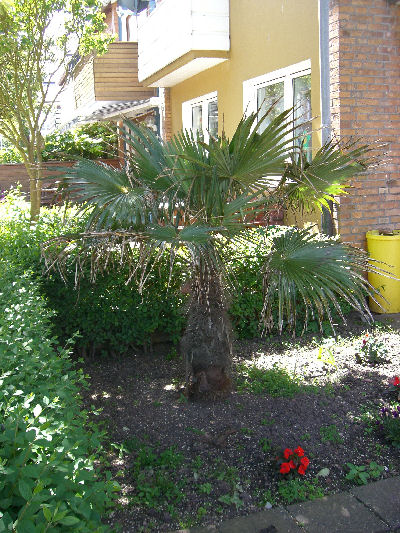
Trachycarpus fortunei in one front garden in the inner-city early June 2009, it's not drawn by frost, but by seasalt winds in the winter.
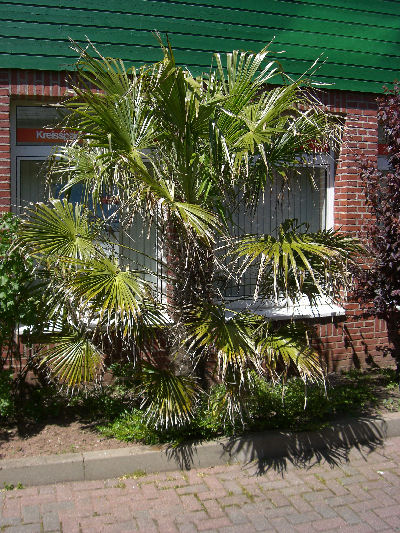
The bank trachy still looks well despite of the damages by seasalt winds.
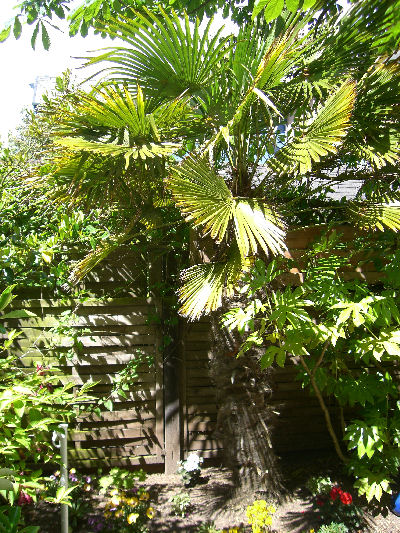
The largest trachy of the down town looks very good, nearly undamaged, obviously it stands very good sheltered against winds.
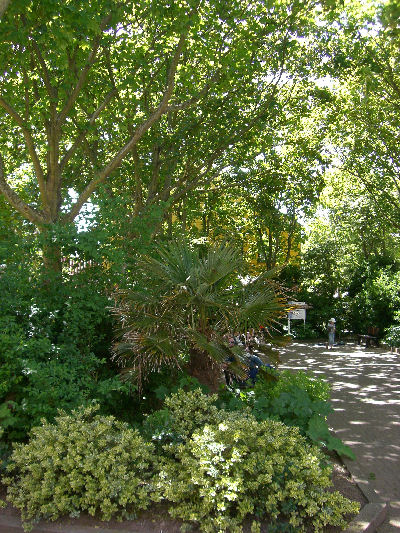
One of the trachies in the small park in the down town early June 2009, kept well.
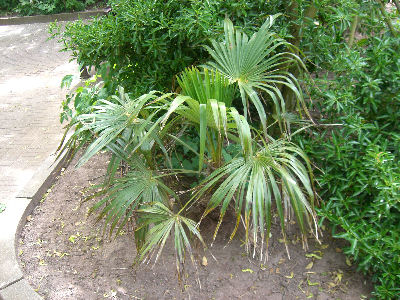
Another trachy in the small park in the down town, it also shows undamaged by the past winter.
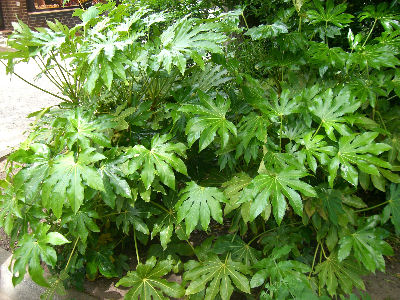
Nearer sight of one huge Fatsia japonica in the down town early June 2009.
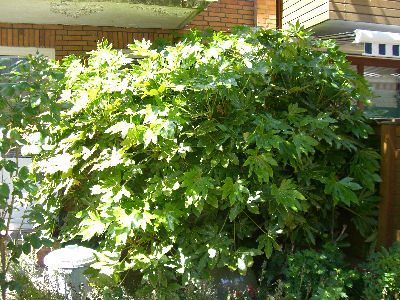
Total picture of one huge Fatsia japonica in the down town early June 2009.
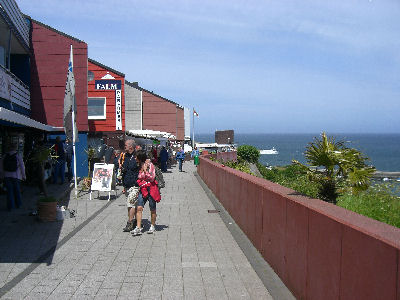
At the right on the picture trachies in the upper town are to recognize behind of the wall, they are there affixed in their pots at the hillside.
Picture gallery "Exotics" in Spring 2009 (unfortunately only in German, please click on!)
Author: Joachim Jaeck
Updated on June, 15th, 2009